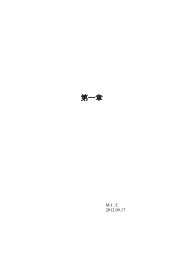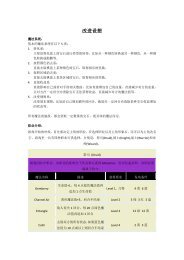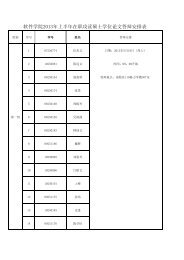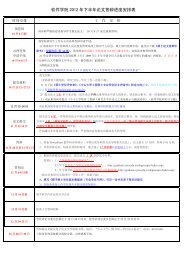A more secure steganography based on adaptive pixel-value ...
A more secure steganography based on adaptive pixel-value ...
A more secure steganography based on adaptive pixel-value ...
You also want an ePaper? Increase the reach of your titles
YUMPU automatically turns print PDFs into web optimized ePapers that Google loves.
Multimed Tools ApplIf gi ′ or gi+1 ′ is out of the range [0,255], then the candidate embedding unit ismarked as aband<strong>on</strong>ed <strong>on</strong>e. Note that such unused units are few in most naturalimages and are very easy to detect.It can be proven that the new absolute difference |d ′ |=|gi+1 ′ − g′ i| in the stegoimage will fall into the same regi<strong>on</strong> R k as the difference |d| =|g i+1 − g i | in thecover image. So in data extracti<strong>on</strong>, if |d ′ |∈R k , the embedded <strong>value</strong> can be extractedcorrectly by b =|d ′ |−l k .In [25], the authors shows that a fixed regi<strong>on</strong> R i employed in the original PVDscheme (Step 2) will introduce some unusual steps in the histogram of <strong>pixel</strong> <strong>value</strong>differences (PVD histogram) for all the embedding units, which can be used toexpose the presence of hidden message and further to estimate the size of hiddenbits. To make the <str<strong>on</strong>g>steganography</str<strong>on</strong>g> immune to PVD histogram <str<strong>on</strong>g>based</str<strong>on</strong>g> analysis, theauthors employ random regi<strong>on</strong>s instead of the fixed regi<strong>on</strong>s when data hiding. Theexperimental results in [25] show that the new approach can effectively eliminatethose undesired steps.To improve the embedding capacity, a new PVD-<str<strong>on</strong>g>based</str<strong>on</strong>g> <str<strong>on</strong>g>steganography</str<strong>on</strong>g> combinedwith LSB technique is proposed by Wu et al. [23]. In this method, Steps 1 and 2 arethe same as it did in the original PVD scheme. After that, if R k bel<strong>on</strong>gs to higherlevel, namely |d| > 15, then embeds secret bits using the original method. Otherwiseif |d| bel<strong>on</strong>gs to lower level, namely |d| ≤15, embeds three bits into g i and g i+1 using3-LSB replacement, respectively. Assume that the <strong>pixel</strong> <strong>value</strong>s after data hiding aredenoted as gi ′ and g′ i+1 ,thencalculate|d′ |=|gi+1 ′ − g′ i |, if the new difference |d′ | is notbel<strong>on</strong>gs to lower level, then readjust them by(g′i , g ′ i+1)={ (gi − 8, g i+1 + 8 ) g ′ i ≥ g′ i+1(gi + 8, g i+1 − 8 ) g ′ i < g′ i+1In a latest work [24], it divides the <strong>pixel</strong> differences into three levels: lowerlevel,middle-level and high-level. Similar to Wu’s approach [23], k secret bits areembedded into g i and g i+1 , respectively, where k = l, m, h, if|d| bel<strong>on</strong>gs to lowerlevel,middle-level and high-level, respectively. After that the method applies themodified LSB approach [1, 5] to the resulting <strong>pixel</strong>s pair and gets the new <strong>pixel</strong> pair(gi ′, g′ i+1 ). If the new difference |d′ |=|gi+1 ′ − g′ i| bel<strong>on</strong>gs to different levels, readjustthem into the following forms:(g′i , g i+1 ′ ± 2k) (or g′i ± 2 k , g i+1)′Finally selects the better choice of the new <strong>value</strong>s gi ′, g′ i+1which satisfies thec<strong>on</strong>diti<strong>on</strong>s that the new difference |d ′ | and the original <strong>on</strong>e bel<strong>on</strong>g to the samelevel and the <strong>value</strong> of |gi ′ − g i|+|gi+1 ′ − g i+1| is the smallest am<strong>on</strong>g the candidates.Compared with [23], the new method can provide stego image with larger embeddingcapacity as well as higher objective quality.2.2 Properties of PVD-<str<strong>on</strong>g>based</str<strong>on</strong>g> <str<strong>on</strong>g>steganography</str<strong>on</strong>g>As described in Subsecti<strong>on</strong> 2.1, the main idea of the existing PVD-<str<strong>on</strong>g>based</str<strong>on</strong>g> approachesis that they first divide a cover image into n<strong>on</strong>-overlapping embedding units withtwo c<strong>on</strong>secutive <strong>pixel</strong>s in a raster scanning manner, and then deal with the embeddingunits separately in a pseudo-random order. For a given embedding unit, the















